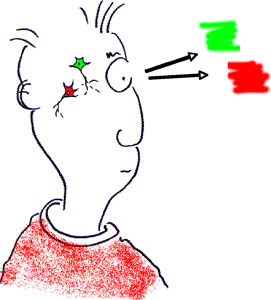This is the first among three empirical workpackages in the FEEL project, and it addresses what is for the philosophers the prototype among feels, namely color. Because color is so basic, demonstrating that the sensorimotor account of color is convincing would be a significant victory for the sensorimotor theory.
The sensorimotor theory must claim that color is a sensorimotor contingency, that is, an abstract law that links our actions to the resulting changes in sensory input.
At first it seems counterintuitive to suppose that experiencing colors should involve actions. But in (Philipona & O’Regan, 2006) we found a surprisingly successful way of incorporating this idea into a theory of color. Still, our approach did not go the whole way in the direction of the sensorimotor theory because the actions we required were not necessarily contingent on body motions — remedying this will be the more ambitious aim of this workpackage.
It is an impressive feat to be able to explain entirely from first principles and without any parameter adjustments two independent facts about color perception, namely anthropological data on color naming and psychophysical data on unique hues. Essentially however our finding is only a correlation of a mathematical property, and the psychophysical and anthropological results. What is needed is a biological explanation for this correlation.
Through simulations we will study the relation between singularity and the ease with which a child, say, can learn to distinguish different surfaces from each other. When we get a better understanding of why we succeeded in Philipona & O’Regan, we will then look at how we could give action a role in the theory that is more satisfactory from the viewpoint of the sensorimotor approach.

